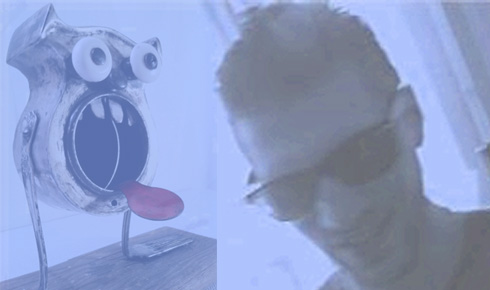 We are a nation of consumers, and as such we like our labels.
We are a nation of consumers, and as such we like our labels.
With food we need to know if it is sugar free, caffeine free, or fat free. With religion we need to know is it Christian, Jewish, Muslim, or Hindu. With politics we need to know if it’s Democrat, Republican, Libertarian, or Independent.
We need our labels in order to function. What are we buying? Who are we talking to? Who are we?
It’s no different when it comes to works of art. We need labels, not so much a price tag, but a label. Tom Shelton of Oakland, NJ refuses to label his art, and without some action by the government to force him to choose a label, he will continue creating art without one.
“I’m really not big on categorizing or labeling my art. I don’t have guidelines when I create. I just let the creative process happen, and whatever comes out is what it is.”
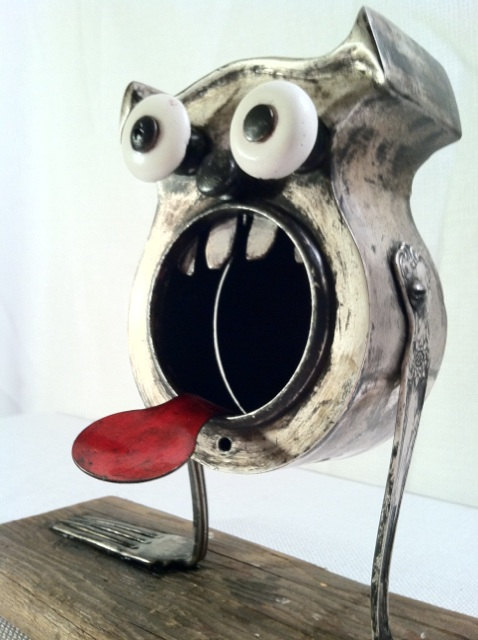 The young Oakland artist has been garnering a lot of recent press with his art work which utilizes found objects, or objects found at garage sales and thrift shops. So, “Found Art” is a term that could readily apply to the art Shelton creates in his Oakland studio…but not really.
The young Oakland artist has been garnering a lot of recent press with his art work which utilizes found objects, or objects found at garage sales and thrift shops. So, “Found Art” is a term that could readily apply to the art Shelton creates in his Oakland studio…but not really.
Found Art is a bit tricky in that it often does not involve the artist creating, so much as finding and putting it in a different context. It evolves from Marcel Duchamp’s idea of ready-made art.
But Tom Shelton could fall under the moniker of Found Art if we look at some pieces by Picasso. Pablo Picasso’s design of a bull’s head utilizing the seat and handlebars of a bicycle is more in tune with finding objects and using them to create a work of art. And Picasso’s ‘Baboon & Young’ sculpture also relates to Shelton’s use of found objects.
But there are other labels to be fostered on Shelton. His work could be also be described as Folk Art which is art not influenced by academic or fine art circles. In this sense, Shelton can certainly be labeled a Folk Artist.
“Without having formal training, I find that it’s a lot of trial and error for me. I don’t know what techniques work in art because I never learned them. And that’s fine. To me, you don’t have to have a degree to be an artist. But if schooling helps people to get to their artistic goals, then that works for them. It just wasn’t the path I took.”
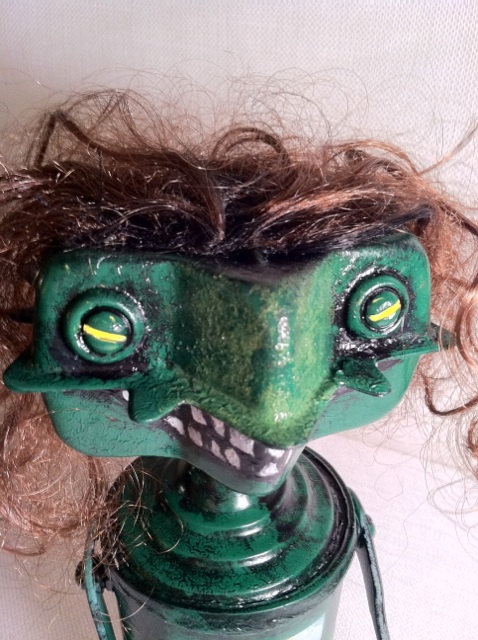 But Folk Art usually reflects some traits or values common to a community or geographic region, and that does not really apply to Shelton. While not having any formal training in art makes him a Folk Artist, his influences would not fall under the Folk Art label. On the contrary…
But Folk Art usually reflects some traits or values common to a community or geographic region, and that does not really apply to Shelton. While not having any formal training in art makes him a Folk Artist, his influences would not fall under the Folk Art label. On the contrary…
“My biggest influence since I was a kid has been Jim Hensen. I’m a big fan of his movies: The Dark Crystal, Labyrinth. His creatures are amazing in how they play off of both the dark and light side. You can’t really label them as creepy or cute. They’re somewhere in between.”
Found Art, Folk Art, perhaps Recycled Art is a good label. Recycled Art is, as the name implies, created with objects that have been recycled. This does not imply everything is made of empty cans, bottles styrofoam and cardboard, but that the object originally had another use prior to being in a work of art. This has led to the creation of the term upcycling.
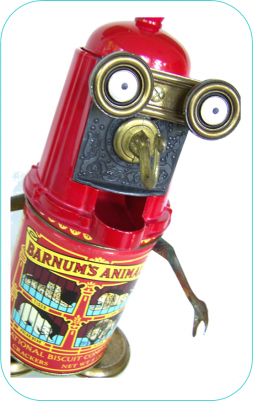 Shelton references using “recycled objects” on his web page, and so the label “Recycled Art” could be used. His sculptures obviously utilize recycled, or upcycled, objects, but the term may not necessarily apply to Shelton as an artist.
Shelton references using “recycled objects” on his web page, and so the label “Recycled Art” could be used. His sculptures obviously utilize recycled, or upcycled, objects, but the term may not necessarily apply to Shelton as an artist.
“I’ve always found myself trying to make sculptures out of something. I’ve done work with pipe cleaners, wood, clay, and pretty much anything I can get my hands on. But it’s only been the past couple of years that I’ve been using vintage tins and recycled metal pieces.”
This leads us to believe that Shelton, as an artist, drifted towards utilizing recycled objects rather than being drawn to the genre of Recycled Art. So, while Shelton might use upcycled objects, he may not necessarily be a Recycled Artist, so to speak.
The label Visionary Art might be a good label for Shelton. This genre is often defined as art produced by self-taught individuals – without formal training; but, it is different than Folk Art in that the works of art arise from an innate personal vision that is revealed in the creative act itself.
“Having a blueprint in art is very challenging for me because even when I create my own pieces, I just let it flow. Whatever comes out is the final product. I really don’t plan out my work at all.”
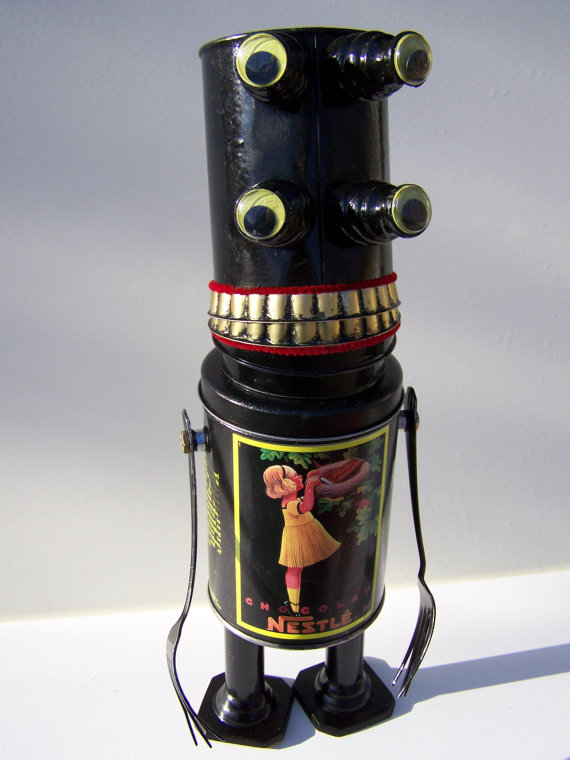 This statement could be used to foster the label of Visionary Art on to Shelton’s sculptures; but Visionary Art is almost a non-label, since no one is really willing to define it much.
This statement could be used to foster the label of Visionary Art on to Shelton’s sculptures; but Visionary Art is almost a non-label, since no one is really willing to define it much.
The Amerian Visionary Art Museum itself does not offer much in terms of defining the label of Visionary Art, but it was recognized by Congress as the “official national education center, repository and museum for self-taught, intuitive artistry.”
Perhaps it’s easiest to not label Shelton’s sculptures, and let the artist’s work speak for itself… And Shelton’s work often seems like it may start speaking at any moment, that it is alive on some unseen level. Almost all of his works evolve into what he describes as critters and creatures which reflect personality, emotion, a life of their own.
“I’ve experimented with abstract works before, but I always gravitate toward creating creatures and critters. Even in paintings, I’m always making faces of some kind.”
Readers can visit Tom Shelton’s website to view more of his work, and keep an eye out for future events and sculptures.
“I have a work-in-progress in my living room. It’s a 4-foot tall guy with lamp bases as legs and a big cooking pot as a head. I would love to make larger pieces, but I’m going to need a bigger studio for that. My basement studio with 6-foot ceilings isn’t going to cut it for long.”
Shelton is also currently working on a project called “Art in Hand” (http://www.artinhandcards.com/). The group is creating a deck of cards that displays the work of one artist from each state on the cards. He has been chosen to represent New Jersey as the 5 of Diamonds. The deck is due to be out this Spring.
Tom Shelton Website:

I am very impressed with the work and the very creative pieces, I am sure this artist will go very far and am very happy to own one of these unique pieces.I feel these pieces will be a collectable and one of a kind art collection.
Guys a certifiable genius. My wife bought three of his pieces in the fall and she wants more! I’ve never seen anything like his work, from the MOMA to the hipster alleys of Brooklyn. He’s a new Warhol of spare parts, a new Bacon working with scrap metal, and a visonary.
I’ve known Tommy for years and have always known he has a hidden artistic talent… but these pieces he’s creating now is the start of something huge… True Genius !
Tom is extremely creative and talented, which is reflected in his unique art. His sculptures, in addition to the recycle/reuse history that the components come along with, Tom brings them together in ways that give each sculpture a personality of its own. The concept of “Gestalt”, where the whole is greater than just the sum of its parts, definitely applies to Tom’s art!